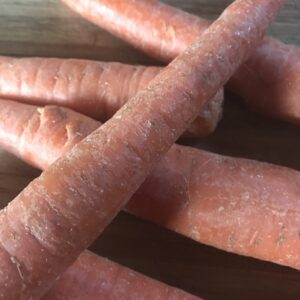A version of this column first ran in the Roane County (WV) Reporter and Times Record. Support local journalism! Subscribe to your local newspaper.
 Another column on using your harvest; this time we’ll talk about carrots and the similar parsnips. First, the parsnips; these are like paler, yellow carrots but can get much bigger. Typically, you plant them in the spring, ignore them all summer, and you can harvest them in the fall but people usually leave them in the ground because they get sweeter after a frost, and will keep till spring. Then you pull them up, wash and slice them and just fry them in butter until they soften. Eaten in April, they helped fill the “hunger gap” of yore, when the meat and saved crops were nearly gone and the new year’s crops (except eggs and milk) just getting planted. We may have hunger gaps again if our supply chains get interrupted, so it’s good to have a well filled larder and some parsnips out in the garden.
Another column on using your harvest; this time we’ll talk about carrots and the similar parsnips. First, the parsnips; these are like paler, yellow carrots but can get much bigger. Typically, you plant them in the spring, ignore them all summer, and you can harvest them in the fall but people usually leave them in the ground because they get sweeter after a frost, and will keep till spring. Then you pull them up, wash and slice them and just fry them in butter until they soften. Eaten in April, they helped fill the “hunger gap” of yore, when the meat and saved crops were nearly gone and the new year’s crops (except eggs and milk) just getting planted. We may have hunger gaps again if our supply chains get interrupted, so it’s good to have a well filled larder and some parsnips out in the garden.
Another traditional use for parsnips is wine, and I tried that once. I thought the result was nasty, tasting like whiskey, but the wino friends I had in those days liked it just fine.
I grew parsnips once recently, and let a couple of the plants go to seed the second year. They surprised me with six-foot stalks, producing surely a thousand seeds; in retrospect, not such a good choice as parsnip seed only keeps a year or two.
Carrots have more uses and are more familiar to today’s cooks. They come in red, yellow and purple, even white, as well as the now traditional orange—but I prefer the orange ones. The orange color indicates the presence of carotene, AKA Vitamin A. But red and purple color can indicate other antioxidants like lycopene and anthocyanin, which also have protective qualities.
Carrots are good raw, eaten as snacks or sliced thinly and added to a salad. Or they can be shredded for carrot-raisin salad.
Among the best uses for a carrot is in soup—practically any soup. Chicken soup wouldn’t be the same without carrots, and they’re also essential in beef and venison stews. And I note that in the column about using potatoes I failed to mention potato chowder—my version uses carrots prominently.
Here’s how I make it: chop the potatoes fairly small and the carrots smaller as they take longer to cook otherwise. Cover with water and boil until you can mash not only the potatoes but the carrots as well. You can run an immersion blender to puree the result—or not. While the potatoes and carrots are cooking, lightly fry onions, garlic and perhaps celery or leeks or bok choy stems in butter; another item that makes this a fine chowder is some kind of salty meat like sausage or bacon, not too much, which can be fried up with these veggies. Throw this mix in after pureeing the potatoes and carrots, and if you have some kind of greens—spinach, kale, bok choy leaves, something like that—add them now. When it starts looking like a thick porridge, add enough milk to thin the mix again, along with salt and pepper to taste; then when it’s threatening to boil, stir in a lot of grated cheese and shut off the heat. I often use cheddar.
Carrots are a good item in a stir-fry; I often slice them on the diagonal, mostly just because it looks elegant. They are also nice in a quiche, perhaps near the top where their orange color adds to the eye appeal, where it emerges from the eggy filling (but I also use red pepper strips for that, and I dust the top with paprika).
Some people run carrots through a juicer, so they can drink their carrots instead of eating them. They are among the sweetest of vegetables, so this works well. This is also the reason for the popularity of carrot cake, made with shredded carrots.
I use shredded carrots in egg rolls, fried up along with shredded cabbage, onions and other vegetables I may have on hand, and minced tofu. Flavorings added toward the end are minced ginger and garlic, curry powder and tamari and nutritional yeast. When this mix cools it goes into egg roll wraps and is deep fried. That’s not the healthiest thing, but I used to panfry or bake them and they just aren’t as tasty that way.
Use the comment section for questions, objections and suggestions.
